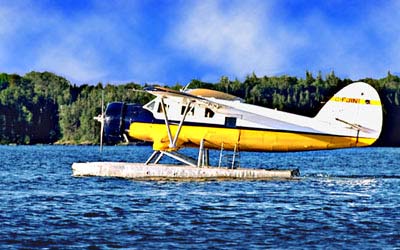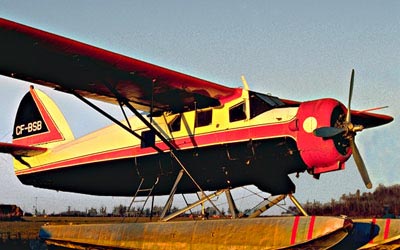 |
Blasts and Boosts
How the Norseman Almost Became a Jet!

 Most aviation
enthusiasts recognize the ear-shattering takeoff roar of fully loaded Noorduyn Norseman
bushplanes. Hot glassy lakes or sub-zero deep snow, one float out of the water or none, it
seems to make little difference. "Canada's Own," as a Noorduyn factory rep once
called it, stands out as an airplane requiring a long takeoff run. A takeoff run that most
bush pilots learned to live with. Most aviation
enthusiasts recognize the ear-shattering takeoff roar of fully loaded Noorduyn Norseman
bushplanes. Hot glassy lakes or sub-zero deep snow, one float out of the water or none, it
seems to make little difference. "Canada's Own," as a Noorduyn factory rep once
called it, stands out as an airplane requiring a long takeoff run. A takeoff run that most
bush pilots learned to live with.
 Since the fabric-covered Norseman made its
first appearance in 1935, however, pilots, mechanics, and non-flyers have come up with
many suggestions to help the pug-nosed freighter struggle over the shorelines. One of the
most peculiar came from a southern Ontario politician who brought up the question of using
solid fuel rocket boosters. The Aerojet Engineering Company of Pasadena, California,
claimed that a JATO or Jet Assisted Take Off bottle could slam a Norseman into the air in
20 seconds or 500 feet. Since the fabric-covered Norseman made its
first appearance in 1935, however, pilots, mechanics, and non-flyers have come up with
many suggestions to help the pug-nosed freighter struggle over the shorelines. One of the
most peculiar came from a southern Ontario politician who brought up the question of using
solid fuel rocket boosters. The Aerojet Engineering Company of Pasadena, California,
claimed that a JATO or Jet Assisted Take Off bottle could slam a Norseman into the air in
20 seconds or 500 feet.
Click on the images for a larger view.
 George Ponsford, chief of the Ontario
government's Provincial Air Service or OPS thought the idea might have merit. Always
cautious before spending taxpayer money, he sent memorandums to several of his experienced
bush pilots with a request for takeoff statistics. During the 1940's the famous OPAS
"Yellow Birds" operated eleven Norsemans to haul conservation officers, fire
fighters, surveyors, and treaty parties throughout the northern reaches of the province. George Ponsford, chief of the Ontario
government's Provincial Air Service or OPS thought the idea might have merit. Always
cautious before spending taxpayer money, he sent memorandums to several of his experienced
bush pilots with a request for takeoff statistics. During the 1940's the famous OPAS
"Yellow Birds" operated eleven Norsemans to haul conservation officers, fire
fighters, surveyors, and treaty parties throughout the northern reaches of the province.
 "What I am trying to determine is whether
or not, in the opinion of those who fly the Norseman an ATO (Auxiliary Takeoff Unit) would
be, if any, particular advantage, " he said. "What I am trying to determine is whether
or not, in the opinion of those who fly the Norseman an ATO (Auxiliary Takeoff Unit) would
be, if any, particular advantage, " he said.
 Reports quickly came back to OPAS head quarters
in Sault Ste. Marie. Pilot Winston Buckworth said a Norseman CF-OBE at a 7,540 pound
(imperial) gross weight with 15 degree of flap averaged 34 seconds to lift off on a
half-mile run. Ponsford estimated that 15 seconds after attaining the on-the-step or
planing position would be the moment to fire the rockets. Aerojet indicated that from that
point, its JATO bottles provided eleven seconds of blast and boost. Reports quickly came back to OPAS head quarters
in Sault Ste. Marie. Pilot Winston Buckworth said a Norseman CF-OBE at a 7,540 pound
(imperial) gross weight with 15 degree of flap averaged 34 seconds to lift off on a
half-mile run. Ponsford estimated that 15 seconds after attaining the on-the-step or
planing position would be the moment to fire the rockets. Aerojet indicated that from that
point, its JATO bottles provided eleven seconds of blast and boost.
 Aerojet vice-president Dan A. Kimball offered
to send an engineer from California to winter-locked Canada to push the project. Not
easily swayed, Ponsford discreetly queried manufacturer Robert B.C. Noorduyn in Montreal.
Noorduyn, however, was not impressed, especially since each JATO unit weighed at least 430
pounds. Aerojet vice-president Dan A. Kimball offered
to send an engineer from California to winter-locked Canada to push the project. Not
easily swayed, Ponsford discreetly queried manufacturer Robert B.C. Noorduyn in Montreal.
Noorduyn, however, was not impressed, especially since each JATO unit weighed at least 430
pounds.
 "The Norseman is about the most unsuitable
airplane anyone would think of as an external structure would have to be built on to it to
take the tremendous thrust of the jets, "he said." The only way I can think of
would be to build it on the float undercarriage struts and the great drag of such a
structure would be carried around throughout the ensuing flight, cutting down the speed
and climb." "The Norseman is about the most unsuitable
airplane anyone would think of as an external structure would have to be built on to it to
take the tremendous thrust of the jets, "he said." The only way I can think of
would be to build it on the float undercarriage struts and the great drag of such a
structure would be carried around throughout the ensuing flight, cutting down the speed
and climb."
 The project went no further than Ponsford's
desk after a survey pointed out that solid fuel propellants were restricted to military
purposes and in short supply. No one mentioned that highly flammable wood, fabric, and
dope made up much of the Norseman airframe. A slight swing of the rocket's flame path
would have rendered the venerable freighter into a tangled mass looking more like a
barbecued muskrat than the classic airplane it truly was. Not a word appeared anywhere
about the effects of JATO blasts on Indian settlements from Attawapiskat to Pauingaussi. The project went no further than Ponsford's
desk after a survey pointed out that solid fuel propellants were restricted to military
purposes and in short supply. No one mentioned that highly flammable wood, fabric, and
dope made up much of the Norseman airframe. A slight swing of the rocket's flame path
would have rendered the venerable freighter into a tangled mass looking more like a
barbecued muskrat than the classic airplane it truly was. Not a word appeared anywhere
about the effects of JATO blasts on Indian settlements from Attawapiskat to Pauingaussi.
 The concept of boosters did not fade quietly.
In 1946, California researchers attached six rockets to the wings of a tiny, two seat
Ercoupe. The pilot, a brave one, ignited a blend of perchlorate, asphalt, and special oils
with an instrument panel switch. In a blinding flash of light and dense smoke, he launched
himself in only 300 feet and 7.5 seconds instead of the Ercoupe's usual 581 feet and 13.1
seconds. The concept of boosters did not fade quietly.
In 1946, California researchers attached six rockets to the wings of a tiny, two seat
Ercoupe. The pilot, a brave one, ignited a blend of perchlorate, asphalt, and special oils
with an instrument panel switch. In a blinding flash of light and dense smoke, he launched
himself in only 300 feet and 7.5 seconds instead of the Ercoupe's usual 581 feet and 13.1
seconds.
 "Should there be a separation between the
fuel and the walls of the combustion chamber, then the flame could penetrate and set off
the whole charge in an explosion," wryly remarked an unimpressed Canadian Aviation
writer. "Should there be a separation between the
fuel and the walls of the combustion chamber, then the flame could penetrate and set off
the whole charge in an explosion," wryly remarked an unimpressed Canadian Aviation
writer.

 Noorduyn Norseman, first
Canadian airplane designed with flaps, was entirely covered in fabric and treated with
weatherproof dope. Several later models were metallized but the pug-nosed freighter would
have been a poor candidate for JATO bottles. Noorduyn Norseman, first
Canadian airplane designed with flaps, was entirely covered in fabric and treated with
weatherproof dope. Several later models were metallized but the pug-nosed freighter would
have been a poor candidate for JATO bottles.
 Canada's first successful civil
JATO demonstration took place on June 11, 1947 when a metal-bellied Fairchild Husky F-11
took 12 seconds to thunder into the sky over Cartierville, Quebec. Surprisingly, pilots
D.D. Murphy and A.M. McKenzie reported only " ...a very slight sensation of
acceleration." The tail had not been raised until Husky CF-SAQ reached 25 miles per
hour. Canada's first successful civil
JATO demonstration took place on June 11, 1947 when a metal-bellied Fairchild Husky F-11
took 12 seconds to thunder into the sky over Cartierville, Quebec. Surprisingly, pilots
D.D. Murphy and A.M. McKenzie reported only " ...a very slight sensation of
acceleration." The tail had not been raised until Husky CF-SAQ reached 25 miles per
hour.
 In 1960, Bristol Aero Industries of Winnipeg
entered the picture after convincing themselves that customers would clamour for JATO on
everything from single engine sport airplanes to heavy transports. They produced drawings
for a belly installation on a Cessna 180 but never sold one. The company also built a
mock-up to fit a de-Havilland Beaver. Bulky and costly, it never went beyond a trial
installation and civil use of firecracker-powered airplanes never took off in Canada. In 1960, Bristol Aero Industries of Winnipeg
entered the picture after convincing themselves that customers would clamour for JATO on
everything from single engine sport airplanes to heavy transports. They produced drawings
for a belly installation on a Cessna 180 but never sold one. The company also built a
mock-up to fit a de-Havilland Beaver. Bulky and costly, it never went beyond a trial
installation and civil use of firecracker-powered airplanes never took off in Canada.

Note from CAGB6@aol.com Just for the record the JATO units
on the Ercoupe did not use the asphalt perchlorate propellants mentioned. That propellant
was used in the production units that were 200, 500, and 1000 lb thrust. That propellant
never exhibited any tendency to de-bond from the walls as described. The units on the
Ercoupe were NEVER used on any aircraft by Aerojet again; that was the only instance.

Top of this story.
Editor John S Goulet
Contacts
Last modified on
April 28, 2007.
© Virtual Horizons, 1996. |
![]()